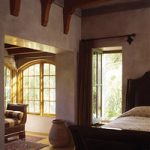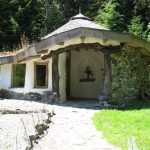By Jeff Deal
Green building might just be the world’s oldest construction style. Caves, lean-tos, waddle and daub, mud brick, stone pyramids and temples, wooden post and beam, Devonshire Cob; all are green building styles, some dating back more than 5,000 years. While there’s not much new under the sun, the resurgent appreciation of these artisan building techniques is not surprising — they’ve been sorely missed. Below are just a few of these nature-inspired approaches. Though brief, it’s a great jumping-off point into the staggering possibilities these construction techniques present.
Straw-bale
Materials: baled waste straw, wheat, rice, rye, or oats covered with a lime- and sand-based plaster.
Advantages: Employs readily available natural and/or recycled materials that provide excellent inherent insulation.
Be Mindful of… A low humidity of the bales must be carefully maintained during construction. Walls must be completely plastered for the life of the house; water should never enter bale walls.
Cob
Materials: compact mixture of clay, sand, straw, water and earth
Advantages: Uses readily available materials that are easy to produce and work with. Provides excellent passive cooling and “thermal momentum” for hotter regions.
Be Mindful of… May not be as good for colder climes as the walls must “breathe” and thus do not provide a high level of insulation. Running water must be kept out of walls.
Earthship/Rammed Earth
Materials: reclaimed tires or bags filled with earth or dense reclaimed materials
Advantages: Utilizes readily available materials that can be easily recovered from local waste streams.
Be Mindful of… As with all buildings, water must be kept out of structural earth walls.
Shipping Container
Materials: Shipping containers with batted, blown or sprayed foam, or foam board insulation
Advantages: Excellent structural integrity and durability. Abandoned containers can often be used.
Be Mindful of… Might need to insulate interior walls with a sprayed-on insulation to avoid condensation in humid climes. Materials are often more industrial and less repurposed than other green systems.
Yurt
Materials: a durable, nimble tent-like frame with a water-shedding outer shell
Advantages: Inexpensive to build and operate.
Be Mindful of… Exterior walls are not as strong as other green building system and are harder to insulate for colder climes.
Structural Insulated Panels (SIPS)
Materials: a dense structural material such as concrete, plywood, OSB or sheet metal with an insulated infill (often foam)
Advantages: Excellent structural integrity, insulation and “thermal momentum” for heating and cooling.
Be Mindful of… Materials are often more industrial and less re-purposed than other green building systems.
More Stories

Leave a comment
Your email address will not be published. Required fields are marked *







Leave a Comment